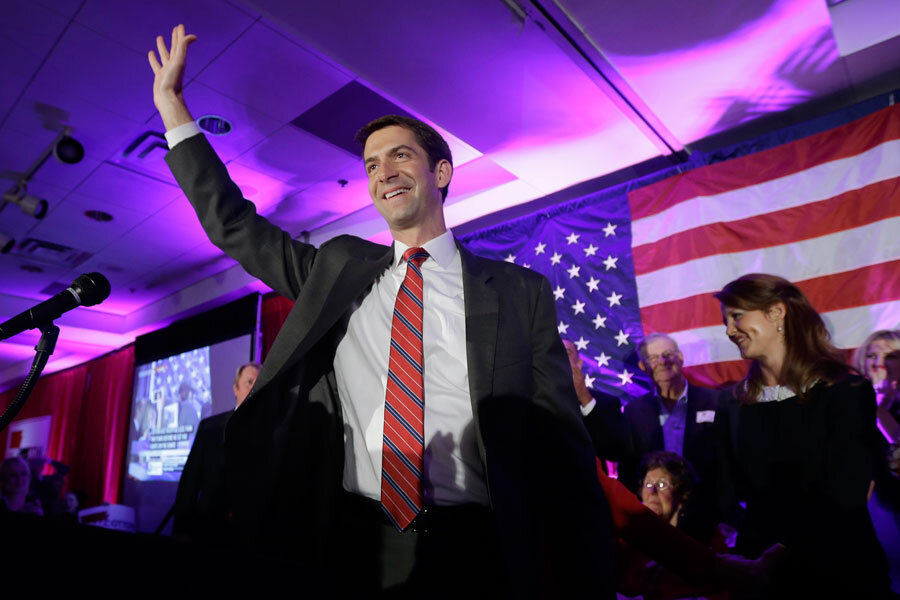Why Republican midterm sweep might be less impressive than it seems
The overwhelming feeling Tuesday night was that everything was changing.
An election that looked like it might come down to the last vote in many states instead became a blowout. Republicans regained control of the Senate, emphatically, and an embattled president found the political walls closing in around him.
So, in the aftermath, questions have naturally turned to, "How might Washington change?" Will President Obama and the Republican Senate find ground for compromise? Would Mr. Obama's proposed executive action on immigration "poison the well" of potential bipartisanship?
Yet all these questions might miss the overarching point of Tuesday's election, which might not mean what it appeared to mean. On the surface, it looked like a Republican victory. In truth, it was a victory for the status quo in Washington. It was further evidence that the Unites States has become Seesaw Nation – tilting Democratic in presidential elections, Republican in midterm elections.
The outlines were already apparent before Tuesday. President Obama rode to power in 2008 in a "wave" election that gave Democrats large majorities in the House and Senate. Republicans tilted the political playing field back in 2010 with a wave election that retook the House. Mr. Obama easily won reelection in 2012 despite being seen as a vulnerable incumbent. Now, another Republican wave has turned the Senate red.
The trend sheds light on one of the reasons why Washington has become so hyperpartisan even as Americans abandon party affiliation in large numbers. But history offers clues as to how such a deadlock could be broken.
So why the electoral whiplash?
It begins with demographics. Fewer voters turn out in midterm elections than in presidential elections, and historically, the folks who don't turn out for midterm elections are younger voters and minorities. That means older, white voters generally determine midterm elections while young voters and minorities can determine presidential-year elections. Obama, for example, won in 2012 with only 39 percent of the white vote.
But that's nothing new. Those trends have more or less held true for decades. What's new is that today's older voters are more conservative than those in the generation before it. The New Deal Democrats who grew up during the Depression and were part of the "Greatest Generation" are gradually being replaced by the Silent Generation, who trend more conservative.
Moreover, all voters are more neatly "sorted" than in the past. That means conservatives vote Republican and liberals vote Democrat. While that might seem logical, politics was not so neatly aligned even a generation ago. The result has been minorities, young voters, and single or highly-educated whites leaning Democratic, while older, married, blue-collar whites lean Republican, notes Ronald Brownstein in The Atlantic.
"In other words, Democrats have become increasingly reliant on precisely the groups most likely to sit out midterms, while Republicans score best among those most likely to show up," he writes.
That combination of demographics and sorting suggests that the US appears to be locked into alternating waves until at least the end of the decade. It also suggests that Tuesday's election did not change the power dynamic in D.C., it cemented it. Slate argues that "our democracy might be hardwired to fail for a generation."
Certainly, the elements are there. Since Republicans currently do best when turnout is low, they are playing to narrower but more motivated base. Take Ohio as an example. Dan Horn of the Cincinnati Enquirer wrote that turnout Tuesday "was so bad it left some grasping for the right words to describe it." Turnout of Hamilton County was the worst for a midterm in 36 years. The only places it was "far better than that"? Areas that leaned Republican.
Compromise is not likely to drive these voters to the polls. Indeed, compromise might deprive Republicans of the one clear advantage they have on Democrats: the enthusiasm that drove their midterm rout.
The drawback, of course, is that the Republicans have in the process made themselves generally unappealing to the presidential-year electorate. This is what made Karl Rove go bonkers that Republicans couldn't defeat Obama in 2012 – in fact, that they couldn't even come close.
And it's not at all clear that the Republican position is sustainable. Not only is the largely-Democratic Latino population growing, but the generation after the Silent Generation is not so clearly conservative. The Baby Boomers have at times swung Republican and Democrat, but at the moment, they lean slightly left, according to Gallup.
That means Republicans will not only have a hard time winning the presidency in the near-term, but their current advantage could disappear in the longer-term.
Slate's Jamelle Bouie offers an interesting perspective on the Republican predicament. The Democratic Party of the 1990s was solidly left-of-center because of its own historical success. Yet it had not won the presidency since Jimmy Carter in 1976. That's when Bill Clinton dragged his party rightward toward the American center. His selling point to liberals? "If you follow me, I can win us the presidency," writes Mr. Bouie.
On Tuesday, the state that shaped Mr. Clinton's politics – arguably the last vestige of the Blue South – ousted Democratic incumbent Sen. Mark Pryor and elected Republican Tom Cotton. The "sorting" of America continues.






